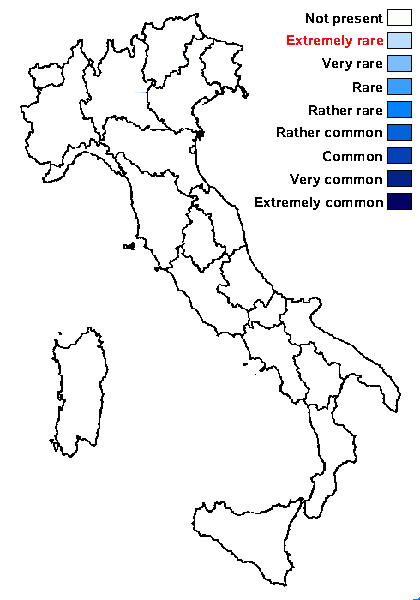Sarcogyne algerica H. Magn.
Medd. Göteb. Bot. Trädg., 12: 120, 1928
Synonyms:
Distribution:
Description: Thallus crustose, thinly episubstratic, whitish, ecorticate, consisting of gelatinized hyphae with scattered algae covering the substrate between dispersed apothecia. Apothecia lecideine, 0.7-1.5(-2) mm across, with a dark brown to black (brown-red when moist), but usually bluish-pruinose disc, and a 0.1-0.15 mm thick, raised, usually persistent proper margin. Proper exciple subparaplectenchymatous, of radiating hyphae with swollen and dark brown tips, the rim dark brown, the inner part colourless; epithecium brown, 10-15 μm high; hymenium colourless, 85-100(-130) µm high, K/I+ blue; paraphyses coherent, simple to sparingly branched, septate, 2-2.5 μm thick, the apical cells 3-4 μm wide; hypothecium colourless, with large crystals. Asci c. 50-spored, cylindrical-clavate, 60-90 x 17-33 μm, strongly thickened at apex, the apical dome K/I-, the outer coat K/I+ blue. Ascospores 1-celled, hyaline, broadly ellipsoid, (5-)7-10(-11.5) x 3-3.5(-4) μm, most of them 7 x 3 μm. Photobiont chlorococcoid. Spot tests: thallus K-, C-, KC-, P-, UV-. Chemistry: without lichen substances.Note: a species described from North Africa and also known from the Iberian Peninsula, mostly growing on calciferous sandstone. To be looked for in Italy.
Growth form: Crustose
Substrata: rocks
Photobiont: green algae other than Trentepohlia
Reproductive strategy: mainly sexual

Predictive model
Growth form: Crustose
Substrata: rocks
Photobiont: green algae other than Trentepohlia
Reproductive strategy: mainly sexual

Predictive model
 Index Fungorum
Index Fungorum
 GBIF
GBIF

